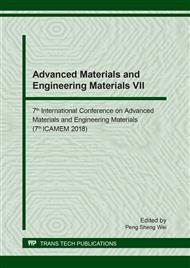[1]
A. Kalendová, D. Vesely´, I. Sapurina and J. Stejskal, Anticorrosion efficiency of organic coatings depending on the pigment volume concentration of polyaniline phosphate, Prog. Org. Coat. 63 (2008) 228-237.
DOI: 10.1016/j.porgcoat.2008.06.005
Google Scholar
[2]
R. Gasparac and C.R. Martin, The effect of protic doping level on the anticorrosion characteristics of polyaniline in sulfuric acid solutions, J. Electrochem. Soc. 149 (2002) 409-13.
DOI: 10.1149/1.1497400
Google Scholar
[3]
Y. Wang, H.D. Tran and R.B. Kaner, Template-free growth of aligned bundles of conducting polymer nanowires, J. Phys. Chem. C. 113 (2009) 10346-10349.
DOI: 10.1021/jp903583e
Google Scholar
[4]
T. Kessler and A.M.C. Luna, Catalytic polyaniline-supported electrodes for application in electrocatalysis, J. Solid. State. Electrochem. 7 (2005) 593-593.
DOI: 10.1007/s10008-003-0360-5
Google Scholar
[5]
L. Brozova, P. Holler, J. Kovarova, J. Stejskal ans M. Trchova, The stability of polyaniline in strongly alkaline or acidic aqueous media, Polym. Degrad. Stab. 93 (2008) 592-600.
DOI: 10.1016/j.polymdegradstab.2008.01.012
Google Scholar
[6]
J. Stejskal, M. Exnerová, Z. Morávková, M. Trchová, J. Hromádková and J. Prokes, Oxidative stability of polyaniline, Polym. Degrad. Stab. 97 (2012) 1026-1033.
DOI: 10.1016/j.polymdegradstab.2012.03.006
Google Scholar
[7]
P. Bobera, T. Lindforsa, M. Pesonenb and J. Stejskal, Enhanced pH stability of conducting polyaniline by reprotonation with perfluorooctanesulfonic acid, Synth. Met. 178 (2013) 52-55.
DOI: 10.1016/j.synthmet.2013.07.002
Google Scholar
[8]
J. Stejskal, J. Proke and M. Trchová, Reprotonated polyanilines: The stability of conductivity at elevated temperature, Polym. Degrad. Stab. 102 (2014) 67-73.
DOI: 10.1016/j.polymdegradstab.2014.02.001
Google Scholar
[9]
S. Suwanprateep, R. Mongkolnavin and V. Pimpan, Environmental friendly synthesis of polyaniline by nitrogen pulsed plasma polymerization, Acad. J. Sci. 1 (2012) 451–457.
DOI: 10.4028/www.scientific.net/amr.488-489.950
Google Scholar
[10]
J. Wang, K.G. Neoh, L. Zhao and E.T. Kang. Plasma Polymerization of Aniline on Different Surface Functionalized Substrates. J. Colloid. Interf. Sci. 251 (2002) 214–224.
DOI: 10.1006/jcis.2002.8389
Google Scholar
[11]
S. Suwanprateep, Syntheses of polyaniline and polyaniline filled with silver particles using pulsed inductively coupled plasma, A Dissertation submitted in partial fulfillment of the requirements for the degree of doctor of philosophy program in materials science, Department of materials science, Chulalongkorn University, Thailand, (2012).
Google Scholar
[12]
X.R. Zeng and T.M. Ko, Structures and properties of chemically reduced polyaniline, Polymer. 39 (1998) 1187-1195.
DOI: 10.1016/s0032-3861(97)00381-9
Google Scholar
[13]
M. Cochet, G. Louarn, S. Quillard, M.I. Boyer, J.P. Buisson and S. Lefrant, Theoretical and experimental vibrational study of polyaniline in base forms: non-planar analysis. Part I, J. Raman. Spectrosc. 31 (2000) 1029-1039.
DOI: 10.1002/1097-4555(200011)31:11<1029::aid-jrs640>3.0.co;2-a
Google Scholar
[14]
Z. Ping, In situ FTIR-attenuated total reflection spectroscopic investigations on the base-acid transitions of polyaniline. Base-acid transition in the emeraldine form of polyaniline. J. Chem. Soc. Faraday Trans. 92 (1996) 3063-3067.
DOI: 10.1039/ft9969203063
Google Scholar
[15]
S.Adhikari and P. Banerji, Enhanced conductivity in iodine doped polyaniline thin film formed by thermal evaporation, Thin Solid Films. 518 (2010) 5421–5425.
DOI: 10.1016/j.tsf.2010.03.080
Google Scholar
[16]
J. Wang, K.G. Neoh, L. Zhao and E.T. Kang, Plasma polymerization of aniline on different surface functionalized substrates. J. Colloid. Interface. Sci. 251 (2002) 214-224.
DOI: 10.1006/jcis.2002.8389
Google Scholar
[17]
G.J. Cruz, J. Morales, M.M. Castillo-Ortega, and R. Olayo, Synthesis of polyaniline films by plasma polymerization, Synth. Met. 88 (1997) 213-218.
DOI: 10.1016/s0379-6779(97)03853-8
Google Scholar


